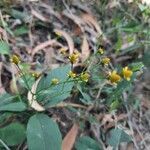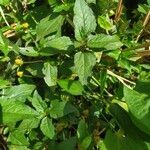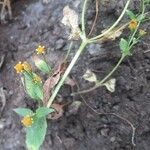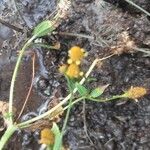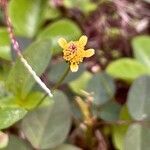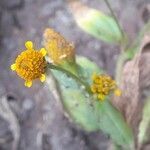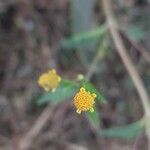Annual herb 30–45 cm high. Leaves subsessile or shortly petiolate, narrowly lanceolate to lanceolate, 20–50 mm long, 6–10 mm wide, entire to sparsely and coarsely toothed, sparsely hispid especially on veins and margins. Capitula terminal and axillary, solitary or in groups of 2 or 3, 4–6 mm diam.; peduncle 2–7 cm long; involucral bracts c. 5 or 6, 1-seriate, narrowly to broadly ovate, 2–4 mm long, ciliate on margins, otherwise glabrous. Ray florets present, yellow to orange yellow, inconspicuous. Disc florets 4-lobed, yellow to orange yellow. Achenes 2.5 mm long, densely ciliate on margins, otherwise glabrous or sparsely pilose. Pappus of 2–4 very short fine bristles almost indistinguishable from marginal cilia.
Annual herb 10–100 cm high; stems erect, scrambling or sometimes decumbent, green or reddish, glabrous or pilose.. Leaves lanceolate, narrowly ovate or ovate, 1–8.5 cm long, 0.3–3 cm wide, base attenuate, margins sinuate to dentate, apex acute to acuminate, glabrous to sparsely pilose; petiole 2–32 mm long, narrowly winged.. Capitula solitary, radiate, 4–6 mm in diameter, 6–8 mm long, on stalks 1–6 cm long; involucre 2–4 mm long, of 1 series of green phyllaries.. Ray florets 4–7, pale yellow, 1.8–3.6 mm long, the ray 0.9–2.2 mm long.. Disc florets many, yellow to orange-yellow, 1–1.6 mm long.. Achenes 1.2–1.8 mm long, ciliate; pappus of 2–4 bristles 0.1–0.7 mm long.
A herb. It grows each year from seeds. It grows 30 cm tall. The stems can be single or several from the base. It is green or purple. The leaf blade is sword shaped and 2-5 cm long by 0.5-2.5 cm wide. There can be teeth along the edge. The flowers are opposite. They are yellow or orange.
